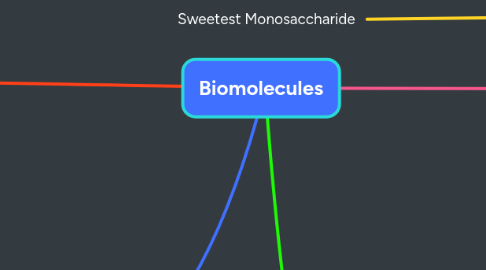
1. **Carbohydrates**
1.1. Non-Sugar
1.1.1. **Properties**
1.1.1.1. Tasteless
1.1.1.2. Amorphous
1.1.1.3. Water Insoluble
1.1.2. Polysacharides
1.2. Sugar
1.2.1. **Properties**
1.2.1.1. Sweet
1.2.1.2. Water Soluble
1.2.1.3. Crystalline
1.2.2. Monosaccharides
1.2.3. **Non-Reducing**
1.2.3.1. Does not reduce mild oxidizing agents
1.2.3.2. Have Acetal Linkages
1.2.3.2.1. R-HC-(OR)₂ (Acetal)
1.2.4. **Reducing**
1.2.4.1. Have Hemiacetal or Hemiketal Linkage
1.2.4.1.1. R-HC(OH)-OR (Hemiacetal) or R₂-C(OH)-OR (Hemi-ketal)
1.2.4.2. Reduces mild oxidizing agents
1.2.4.2.1. Tollen's Reagent
1.2.4.2.2. Fehling's Solution
1.2.4.2.3. Benedict's Solution
1.2.5. Oligosaccharides
1.2.6. **Common Sugars**
1.2.6.1. Sucrose
1.2.6.1.1. Inverted Sugar
1.2.6.2. **Glucose**
1.2.6.2.1. **Glucose Reactions**
1.2.6.3. Maltose
1.2.6.4. Lactose
1.2.6.5. **Fructose**
1.2.6.5.1. Sweetest Monosaccharide
1.2.6.5.2. Fruit Sugar
1.2.6.6. Starch
1.2.6.6.1. Amylase (Linear)
1.2.6.6.2. Amylopactin (Branched)
1.2.6.7. Cellulose
1.2.6.8. Glycogen
1.2.7. **Nucleoside**
1.2.7.1. **Nucleotide**
1.2.7.1.1. Nucleoside + Phosphoric Acid
1.2.7.2. Sugar + Base
1.3. **Stereomerism**
1.3.1. **Anomers**
1.3.1.1. Difference in configuration of C₁ (Aldose) or C₂ (Ketose).
1.3.1.2. Epimers
1.3.1.2.1. Difference in configurations of *any Chiral Carbon.*
1.3.2. **Muta-rotation**
1.3.2.1. Shifting of Optical Rotation due to shift in equilibrium between α- and β- Anomers.
1.4. **Osazones**
1.4.1. D-Glucose
1.4.2. D-Mannose
1.4.3. D-Fructose
1.4.4. Formed by reaction of sugars with Phenyl Hydrazine (Ph-NH-NH₂)
1.4.4.1. **3-Equivalents**
1.5. **Glycosides**
1.5.1. Acetates of Carbohydrates
1.5.2. Does not give Muta-rotation
1.5.3. Does not reduce mild oxidizing agents
1.6. Tests for Carbohydrates
1.6.1. Molish Test
1.6.2. Barfaed Test
1.6.3. Seliwaroff's Test
1.6.4. Bials Test
1.6.5. Osazone Test
1.6.6. Iodine Test
2. **Amino Acids and Proteins**
2.1. Contains both Amine and Carboxylic Acid
2.2. **Classification**
2.2.1. On Basis of Body Requirement
2.2.1.1. Essential Amino Acids
2.2.1.1.1. Needs to be included in diet, cannot be synthesized by body
2.2.1.2. Semi-Essential Amino Acids
2.2.1.2.1. Body can synthesize but not enough, needs to be included in diet
2.2.1.3. Non-Essential Amino Acids
2.2.1.3.1. Body can synthesize them enough for requirements, no need to be included in diet.
2.2.2. On Basis of Chemical Nature
2.2.2.1. Acidic Amino Acids
2.2.2.2. Neutral Amino Acids
2.2.2.3. Basic Amino Acids
2.3. Proteins are Natural Polymer of α-Amino Acid
2.3.1. Have more than 100 Amino Acids and molar mass higher than 10,000u.
2.3.1.1. Exception: Insulin has only 51 Amino Acids.
2.4. **Structure of Protein**
2.4.1. Primary Structure
2.4.1.1. Contsians Peptide Bond
2.4.1.2. The specific sequence of Amino Acids
2.4.2. Secondary Structure
2.4.2.1. The shape of protein structure in a long polypeptide chain.
2.4.2.1.1. α-Helix Structure
2.4.2.1.2. β-Pleated Structure
2.4.3. Tertiary Structure
2.4.3.1. The further folding of secondary structure due to hydrogen and sulphide bonds.
2.4.3.1.1. Fibrous (Parallel Chains)
2.4.3.1.2. Globular (Coiled Chains)
2.4.4. Quaternary Structure
2.4.4.1. Formed by interation of two or more poly-peptide chains
2.5. **Tests for Amino Acids and Proteins**
2.5.1. Biurate Test
2.5.2. Ninhydrin Test
2.5.3. Xamthoprotix Test
2.5.4. Sakaguchi Test
2.5.5. Millon's Test
2.6. **Nucleic Acid**
2.6.1. Chromosome = Nucleic Acid + Protein
2.6.2. Rhibo-Nucleic Acid (RNA) Polymer of Nucleotide
2.6.3. Deoxy-rhibo-Nucleic Acid (DNA) Polymer of Nucleotide
2.7. **Enzymes**
2.7.1. Specific Catalyst for a specific Biological Reaction
2.7.2. Act on other specific substrate only
2.7.3. All Enzymes are Globular Proteins
2.7.4. Their name is generally originated from their source
2.7.5. Increases Rate of Reaction by decreasing Activation Energy
3. **Hormones**
3.1. Compounds that are secreted by Endocrine glands, carried away by blood to perform physiological activity
3.2. They act at place other than their origin
3.3. They controll cell/tissue growth, organ function, blood pressure etc.
3.3.1. Amino Acid Derivation Hormones (Epinephrine, Norepinephrine)
3.4. Examples
3.4.1. Peptide Hormone (Endophines, Insulin)
3.4.2. Steroid Hormone (Estrogen, Androgens)
4. **Vitamins**
4.1. Organic Compounds required in small amounts in diet for specific bodily functions and maintanance.
4.2. Classification
4.2.1. Fat Soluble
4.2.1.1. Stored in Liver
4.2.1.2. Not needed to be supplied too often
4.2.1.3. Vitamin A, D, E, K *(attack)*
4.2.2. Water Soluble
4.2.2.1. Cannot be stored in body Exception: Vitamin B₁₂
4.2.2.2. Needs to be supplied very often
4.2.2.3. Vitamin B, C
4.3. **Vitamins and Deficiency Disease**
4.3.1. Vitamin A
4.3.1.1. Night Blindness
4.3.2. Vitamin B₁
4.3.2.1. Beri-Beri
4.3.3. Vitamin B₂
4.3.3.1. Retarted Growth
4.3.4. Vitamin B₁₂
4.3.4.1. Anaemia
4.3.5. Vitamin C
4.3.5.1. Scurvy
4.3.6. Vitamin D
4.3.6.1. Rickets
4.3.7. Vitamin K
4.3.7.1. Excessive bleeding during injury
